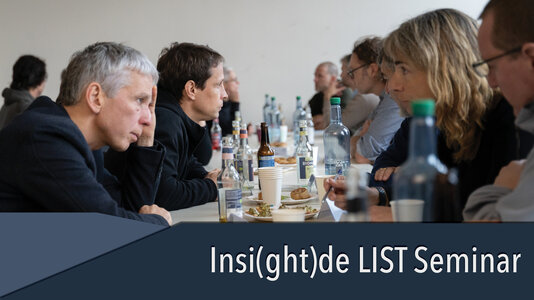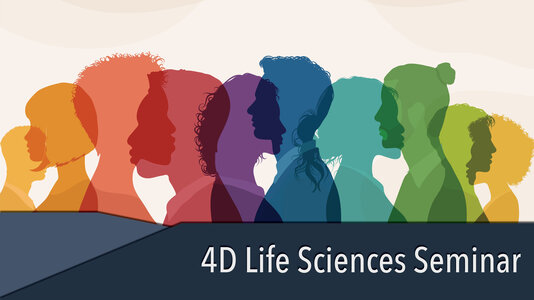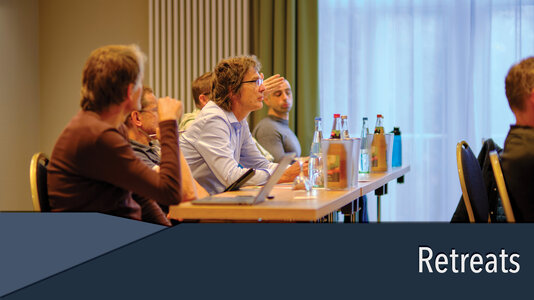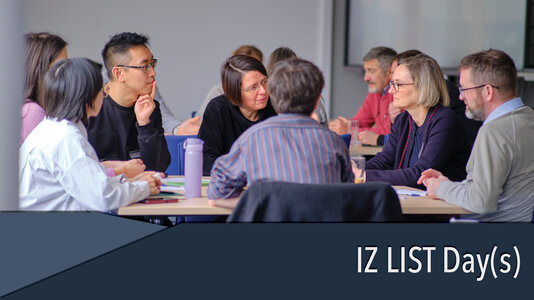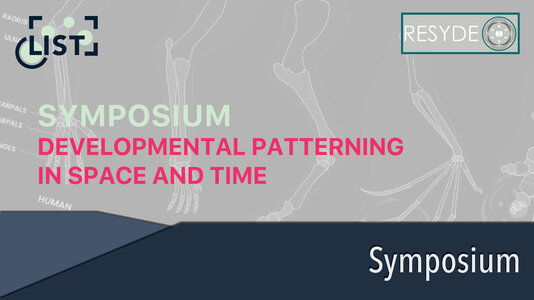News and Events
-

Survival of the weakest?
Evolution under random environments and skewed reproduction
-

From doom to zoom!
Scenario-powered city scoring...
-

When metals get all excited!
Plasmons spark an allyl makeover...
-
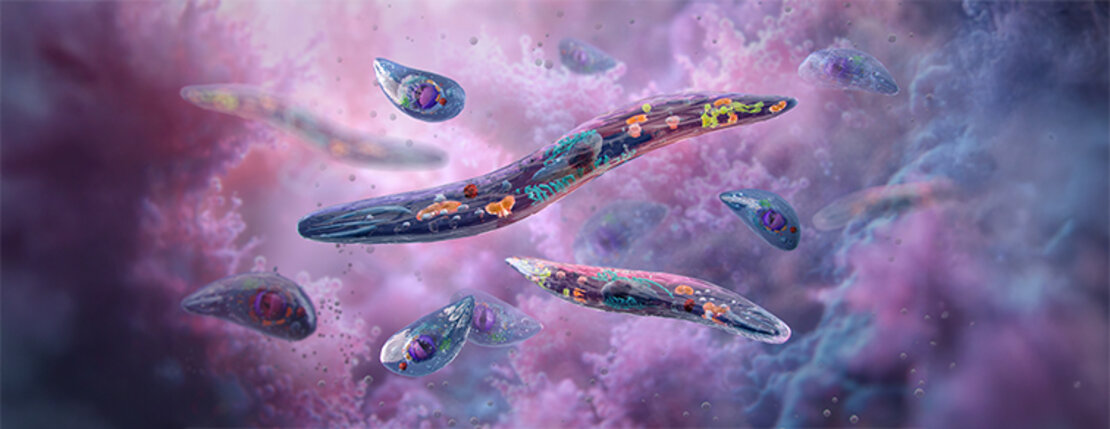
Digesting Danger!
CRT’s long haul through the malaria life cycle...
-

No GEP, No Go!
How malaria parasites miss their big date...
-

Let's mix again!
Diffusing Apart... Until Noise Tells Them Not To
2025

Where play meets planet!
Green spaces aren't just pretty! They are crucial urban infrastructure for public health and climate resilience. Nowhere is this more vital than in kindergartens, where green outdoor areas are essential for a child's holistic development—from physical activity to fostering a connection with nature. Dagmar Haase systematically evaluated the capacity of kindergarten green spaces in Leipzig, Germany, to support both children's development and climate resilience. Through detailed mapping and interviews across 21 sites, she analyzed existing green and blue elements, including vertical gardens, planting, water management, and biodiversity features. Her analysis confirmed that enhancing these areas with Nature-Based Solutions (NBS) is highly effective, strengthening climate resilience against increasing summer heat, promoting biodiversity, and supporting the social well-being of young children. If you want to learn more about how to transform playgrounds into climate-resilient, nature-rich learning spaces across Germany and Europe, check out her Urban Forestry & Urban Greening Article!

From Heat Islands to Sponge Cities!
Our cities are at a breaking point. As global warming intensifies, urban centers worldwide face a double threat: devastating flash floods and relentless extreme heat. The hard, sealed-off surfaces that define modern infrastructure are simply not built to handle the future climate, turning heavy rainfall into disaster and sunny days into unlivable 'heat islands.' The innovative concept of the 'Sponge City' offers an elegant solution, designing urban areas to absorb, clean, and store rainwater. But the key question remains: Can we effectively retrofit our vast, existing urban centers? Dagmar Haase explored the answer through a detailed case study in Leipzig, Germany, comparing two contrasting neighborhoods—a dense old district and a prefabricated housing estate. Check out her Frontiers in Environmental Science Article if you want to receive an actionable roadmap for planners, demonstrating that every square meter of existing urban fabric holds the key to building a more resilient, cooler future!

Temperature isn't simple
In systems at thermal equilibrium or close to it, temperature is a well-defined property that can be measured in multiple ways, and all measurements will more or less agree. However, for systems that are far from equilibrium, there is no universal definition of temperature. In these systems, the concept of effective temperature is used as a way to extend the ideas of equilibrium statistical mechanics. The Theory of Complex Systems and Neurophysics Group (Benjamin Lindner) studied the limitations of the effective temperature in a single inertial probe with self-propelled active walkers. Therefore, they compared the temperature values determined by different definitions (a generalized fluctuation-dissipation relation, a kinetic temperature, and a work fluctuation relation). The results show a high consistency of the measurements under certain conditions as well as regimes where the consistency breaks down. If you want to know more about the limits of effective temperature, read this paper.
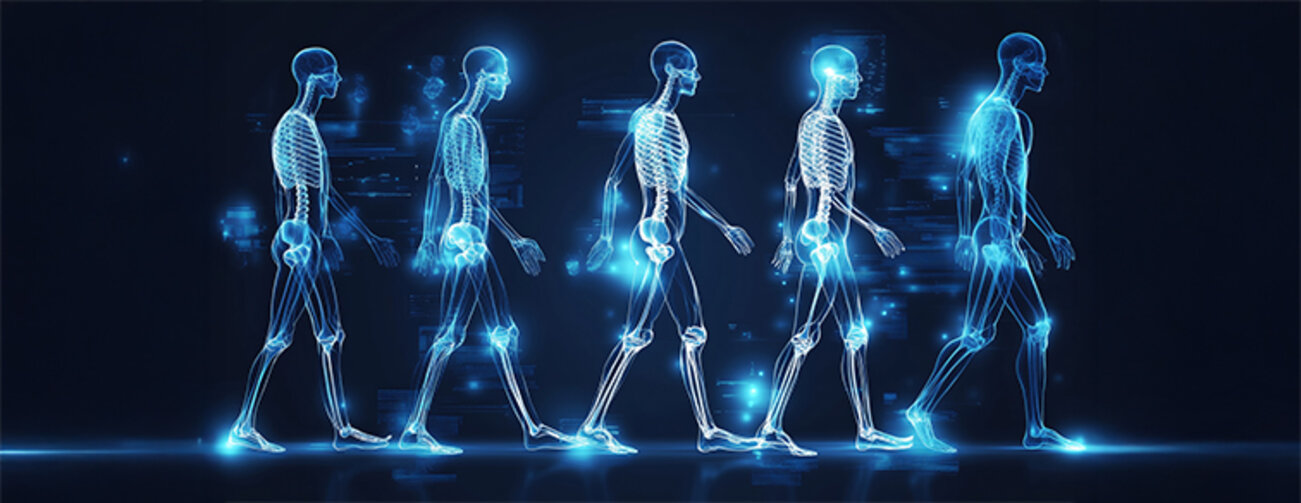
Don't stop me now!
Imagine taking a walk where every step is separated by a random pause — sometimes quick, sometimes very long.This is the essence of a continuous-time random walk (CTRW), a mathematical model scientists use to understand unpredictable motion in systems ranging from stock markets to the movement of particles in cells. Igor Sokolov addressed the question: if we know where such a 'walker' ends up after a long time, what can we say about how many steps it took to get there? He discovered surprising patterns: the distribution of step numbers follows universal rules that differ depending on whether the motion looks like normal diffusion (a typical random spread) or subdiffusion (slower, more constrained wandering). Even more, the average number of steps can be calculated from the displacement patterns alone — shedding light on how random waiting times shape both ordinary and rare outcomes in complex systems. Step into his Physical Review Article to explore the hidden rules of random walks.

Focus Pocus!
Why do we remember some things better than others? It often comes down to where we direct our attention. Psychologists have long known that focusing on certain information can boost recall, but it’s been unclear whether attention shapes what we see in the moment as strongly as it shapes what we hold in memory afterward. The Distributed Cognition and Memory Group (Thomas Christophel) tested this by comparing how cues given before and after visual stimuli affected recall. They found that while attention improved performance in both perception and memory, its effects were stronger during perception - what we pay attention to at the start leaves the sharpest imprint. You should definitely pay attention to their Journal of Vision Article!

The wild side of cities!
Cities are often seen as concrete jungles - yet, paradoxically, they represent the primary point of contact with nature for most humans today. Despite this vital connection, our knowledge on the status and trends of biodiversity in urban areas is scattered and biased, making it challenging to understand and protect the ecological wealth concentrated within our metropolitan centers. As part of the German Biodiversity Assessment, the Landscape Ecology Group (Dagmar Haase) found that urban areas host a large proportion of the nation's species, making them vital for conservation. However, the number of studies analyzing species trends in cities is small, preventing us from identifying clear general patterns of decline or growth. To safeguard this urban ecological wealth, it is essential to preserve environmental heterogeneity (parks, ponds, gardens) and strictly limit new impervious areas. Currently, local authorities are ill-equipped to systematically monitor this diverse life. You should absolutely check out their Basic and Applied Ecology Artcle, where they discusses these gaps and suggests key attributes for an effective national monitoring system to finally support urban biodiversity conservation!

Smile and I trust you
When meeting a new person, the first impression is crucial. Immediately, we have a feeling about the person: Friendly or not? Trustworthy or not? And this is partially due to emotional expressions that we notice on the other's face. Often, we unconsciously copy the facial expressions, which is called emotional mimicry. But how is this facial mimicry related to the trait association? The Social and Organizational Psychology Group (Ursula Hess) investigated this by doing 3 experiments. In all of them, the participants were asked to appraise social characteristics of the target person which expressed different emotions. Interestingly, the mimicry of happiness was causally linked to the perception of trustworthiness. A correlation between sadness mimicry and less trust in the target person could be found in only two of the three experiments. They concluded that facial mimicry does affect the social trait judgement. If you want to find out more about the affect of mimicry, read the full Emotion Article.

To block or not to block?
Malaria remains one of the world's most devastating infectious diseases, responsible for hundreds of thousands of deaths annually, predominantly among young children in sub-Saharan Africa. The development of a vaccine against the parasite Plasmodium falciparum is challenging due to the parasite's complex life cycle and its ability to constantly mutate and evade the immune system. The fight against the disease is done by conventional control measures, where a highly effective vaccine would be a big step in the elimination of malaria. The recent success in developing and deploying the two vaccines RTS,S and R21/Matrix-M is important, but their efficiency can still be improved. The Molecular Parasitology Group (Kai Matuschewski) now tested the approach of chemo-attenuation in order to prevent the parasite from replicating inside the host. They used live, whole sporozoites (SPZ) along with a common antimalarial drug combination, atovaquone–proguanil (AP). In mice, the combination led to an early arrest of the parasites and a robust immune response. In human trials, it was able to prevent blood stage infections. A comparison with another vaccine-dug combination which allowed for some parasite replication showed a reduced lasting immune response in the PfSZ-CVac (AP). Therefore, the complete blockage of parasite replication might be less effective for a longer protection. If you want to know more about the research on malaria vaccines, read the Molecular Medicine Article.

It takes a city to make a difference!
For too long, cities have been viewed as the primary engines of our biggest problems: climate change, biodiversity loss, and stark socio-economic inequality. But what if the cause is also the cure? In her perspective Dagmar Haase takes a fresh, optimistic look at the urban core. Cities aren't just dense centers of consumption; they are unparalleled reservoirs of innovative talent and communicative power. By unlocking these unique features, she believes global change key drivers can make things better. Check out her Frontiers in Environmental Science Perspective to explore the immense potential inherent in the urban system - our last, best chance in the global race to prevent critical tipping points and build a truly resilient world.
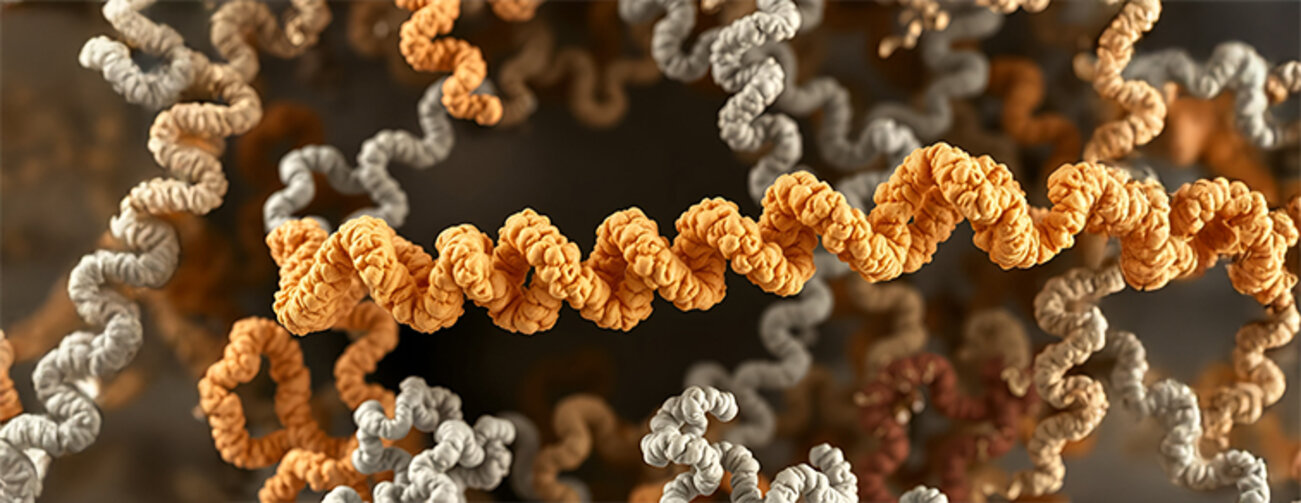
Sweet Chemistry!
Sugars do more than sweeten our biology — they shape it. Mucins, the heavily O-glycosylated proteins that protect our airways and digestive tract, owe their unique mechanical properties to dense sugar clusters decorating long, repetitive peptide regions. Yet, directly probing how such clustered O-glycosylation influences peptide structure has long been a chemical challenge, as synthesizing long glycopeptides with full glycan occupancy remained out of reach. The Bioorganic Synthesis Group (Oliver Seitz) presents an efficient and sustainable synthesis strategy that achieves unprecedented levels of mucin-like glycosylation. Using a fully automated, DMF-free solid-phase synthesis in 1,3-dioxolane (DOL) and small amounts of Tween-20, they produced MUC5AC glycopeptides containing up to 30 GalNAc residues - representing complete glycosylation of all possible sites. Biophysical analyses revealed that increasing GalNAcylation progressively stiffens the peptide backbone, shifting its conformation from a flexible random coil to an extended polyproline II helix. These findings illuminate how sugar clustering determines mucin structure and provide a foundation for exploring the biophysical roles of glycosylation in health and disease. Find out more in their Angewandte Chemie International Edition Article!

Symposium - Developmental Patterning in Space and Time
01-09-2025 (Bernhard von Langenbeck Room, Langenbeck Virchow Haus)
Our one-day symposium 'Developmental Patterning in Space and Time' brought together researchers from plant and animal systems to explore how similar principles underlie the diversity of life. Talks highlighted how positional information is generated, how dynamic processes drive pattern formation, and how developmental programmes evolve and adapt.

Ash-tonishing news
The Common Ash (Fraxinus excelsior L.) is often infected by Hymenoscyphus fraxineus. The fungus infects the trees via the leaves, from where it spreads to twigs, branches or the trunk. It can cause necrosis or ash dieback (ADB). Phenolics, which are frequent in ashes, are thought to be important for plant responses to abiotic stress and pathogen attack, particularly from fungal organisms. The Urban Plant Ecophysiology Group(Christian Ulrichs) studied the phenolic content in the context of ADB and investigated its potential for monitoring the disease. They found site-specific differences in the total phenolic content and individual phenolic profiles. While the temporal differences between leaves collected at different years were lower but still significant, the crown condition had a low impact on phenolic content. They concluded that no robust phenolic biomarker for ADB could be found in mature trees. If you want to know more about the relation between phenolic content and ADB, read the forests article.

SLEUTH and the City
Cities are living organisms — they grow, sprawl, and reshape the land around them. But predicting how a city will expand in the future is no simple task, especially when urban planning policies and land protections come into play. In Shanghai, one of the world’s fastest-changing megacities, understanding future growth is critical for balancing development with farmland preservation and ecological health. The Landscape Ecology Group (Dagmar Haase) used the SLEUTH urban growth model to explore how different scenarios from Shanghai’s Urban Master Plan could shape the city’s expansion through 2060. By simulating a range of planning approaches — from strict land-use protection to more relaxed development — they revealed how urban growth alters not only the city’s footprint but also the surrounding landscape patterns. The results shed light on the trade-offs between growth and conservation, offering valuable lessons for urban planning worldwide. If you're curious about Shanghai’s future skyline and farmland fate, step into their Earth Systems and Environment Article and see it unfold!

The Glowcose Effect
Have you ever noticed how honey flows differently than water — slow, thick, and resistant to movement? Scientists use this property, called viscosity, to understand how molecules move and interact in different environments. To 'see' these invisible changes, researchers often rely on special fluorescent dyes known as molecular rotors. These dyes glow more brightly or dimly depending on how freely they can twist and rotate, making them powerful sensors of their surroundings. The Bioorganic Synthesis Group (Oliver Seitz) focused on a new twist — literally. By attaching a boronic acid group to a classic rotor dye called CCVJ, they discovered that the dye doesn’t just respond to viscosity. It also lights up strongly when it binds to glycans, the complex sugar structures that coat the surfaces of cells and play key roles in biology. This effect, which they call glycan-induced fluorescence enhancement (GIFE), gives them a new way to detect and study these sugars — even in environments where viscosity varies. Explore the their Chemical Communications Article to discover how glycans turn on the glow.

A picture is worth a thousand words...
How does your brain hold on to what we see, even after the image is gone? For decades, scientists thought visual working memory worked like a mental snapshot stored in a single place. But new research shows it’s far more dynamic: the brain spreads the load across multiple regions, storing both precise visual details and more abstract, language-like descriptions at the same time. Using fMRI, the Distributed Cognition and Memory Group (Thomas Christophel) traced how different brain areas encode orientations, spatial positions, and even words like “vertical.” Their findings reveal that visual memory is not just about vision — it also taps into spatial maps and language systems, working together to keep our mental world alive. Find out more about the fascinating world of visual working memory in their Journal of Vision Article!

Fast & Fin-telligent!
When danger looms, there’s safety in numbers - but do big groups also panic more easily? In the wild, animals often make life-or-death decisions together, yet it hasn’t been clear whether larger groups are better at spotting real threats without overreacting to harmless ones. The Collective Information Processing Group (Pawel Romanczuk) & the Mechanisms and Functions of Group-Living Group (Jens Kause)examined the behaviour of fish shoals and found that bigger groups aren’t just faster at detecting predators, they’re also no more likely to fall for false alarms. In fact, larger shoals make decisions both quicker and more accurately, avoiding the usual trade-offs that solitary individuals face. These findings highlight how collective intelligence can sharpen survival strategies in nature. Find out more in their Science Advances Article!

Paving the way for nature in cities...
Can planting trees really make our cities healthier, fairer, and more resilient? Nature-based solutions (NbS) are increasingly promoted as a way to tackle urban challenges — from climate risks to social inequality — but do they really deliver? The Landscape Ecology Group (Dagmar Haase) took stock of the rapidly growing NbS research, reviewing 61 articles and gathering insights from experts across seven world regions. The results highlight not only the promise of NbS, but also key gaps: success depends on local ecological knowledge, inclusive governance, and putting justice at the heart of urban planning. They outlined four pathways to scale up NbS globally — from stronger research and innovation to political will and financing — to ensure nature can truly help shape sustainable cities. Find out more in their Proceedings of the National Academy of Sciences of the United States of America Article.

Pig your brain!
The study of animal behavior often reveals a world of intricate and strategic choices, challenging the long-held assumption that complex decision-making is a uniquely human trait. From the smallest insect to the largest mammal, every animal is constantly faced with a series of decisions that directly impact its survival and reproductive success. These choices, though often appearing instinctive or simple, are the result of a sophisticated interplay between an animal's genetics, its past experiences, and its immediate environment. Analyzing these behaviors allows us to better understand the evolutionary pressures that have shaped animal cognition and the diverse strategies they employ to thrive in a constantly changing world. The Animal Husbandry and Ethology Group (Lorenz Gygax) studied the effects of short-term emotion and long-term mood on Judgement Bias Tasks (JBT) in pigs. The pigs were trained to do a Go/No-go task under different circumstances. To affect the mood and emotion of some pigs, five minutes of positive interaction with a familiar human were used either during the 3 weeks of training (mood) or during the tests (emotion). Since results did not show significant differences between the groups and all pigs had developed a positive relationship with the experimenter over the course of the study, they concluded that another type of treatment would be better to study JBT when training requires regular contact with humans. If you want to know the details of the experiment, read the Applied Animal Behaviour Science Article.

Bacteria's Secret Weapon: YebC!
The field of bacterial translation has long been a focal point for understanding fundamental biological processes and identifying potential targets for antimicrobial strategies. While the core machinery of protein synthesis, the ribosome, is well-understood, the nuanced roles of various accessory factors that fine-tune this process are continuously being uncovered. These factors include RNA-binding proteins (RBPs), a diverse group of molecules critical for regulating gene expression at the post-transcriptional level. However, it remains hard to fully understand many RBPs and their specific functions in bacterial physiology and pathogenesis are still being clarified. A paper of the Molecular Microbiology Group (Marc Erhardt) delves into this fascinating area by identifying novel RBPs in the human pathogen Streptococcus pyogenes and uncovers the role of the conserved protein YebC in optimizing the translation of challenging amino acid sequences. They also studied its effect on physiology and virulence of the bacteria. If you want to know everything about YebC in bacteria, read the Nature Communications Article.

Are we natura-lly failing?
Setting land aside for nature is a critical step toward halting biodiversity loss - but is it enough? Across the European Union, the Natura 2000 network is meant to safeguard biodiversity under the Habitats Directive, yet signs of ecological decline persist. The Landscape Ecology Group (Dagmar Haase) took a closer look at how these protected areas are actually performing in Germany. Drawing on data from over 1,000 Natura 2000 sites, they found that just 6% of habitats and 4% of species are in favourable conservation status - far from the goals set by EU legislation. Their analysis reveals that land use, especially agriculture and forestry, continues to weigh heavily on conservation outcomes, though not all practices are equally harmful. Larger sites, earlier protection, and less direct human use were all linked to better results. The takeaway? Designation alone doesn’t deliver biodiversity recovery. Without stronger restoration efforts and better land-use management, the EU’s 30-by-30 vision risks falling short. Their Basic and Applied Ecology Article study sheds light on where and why protection isn’t working - and what it will take to turn that around. You should definitely check it out!

Malaria's metabolic misery...
Malaria parasites rely on host cell metabolism to survive - what if we could turn that dependency against them? The Molecular Parasitology Group (Kai Matuschewski) uncovered a critical role for sphingolipid metabolism, specifically acid sphingomyelinase (Asm), in supporting Plasmodium infection. They show that Asm activity increases in infected mice, raising ceramide levels in red blood cells. Blocking Asm with amitriptyline reduces parasitemia, protects against disease pathology, and preserves the blood-brain barrier in Plasmodium berghei infections. In vitro, amitriptyline impairs P. falciparum growth by disrupting glucose uptake and parasite development. These findings highlight a novel host-targeted approach to combat malaria by interfering with parasite-supportive lipid pathways. Check out their Biomedicine & Pharmacotherapy Article!

Mission: Immuno-Possible!
Malaria remains one of the world’s deadliest infectious diseases, caused by Plasmodium parasites and transmitted by mosquitoes. To control and clear the infection, the immune system relies on a coordinated response involving various cell types, including T cells, B cells, and specialized antigen-presenting cells (APCs). Dendritic cells (DCs) are among the best-known APCs, but even in their absence, some T cell activity persists, raising the question: who else is helping? The Molecular Parasitology Group (Kai Matuschewski) explored this question in detail using a mouse model of Plasmodium yoelii infection. Their new findings reveal that macrophages in the spleen, especially those in the marginal zone and red pulp, play a crucial supporting role. These cells not only help activate CD4+ T cells but also directly contribute to clearing infected red blood cells. By selectively depleting different macrophage subsets, The Molecular Parasitology Group uncovered distinct and essential roles for each type. These insights highlight the complex interplay between immune cells during malaria and open up new avenues for understanding how the body defends itself against this persistent pathogen. Find out more in their Frontiers in ImmunologyArticle!

Is Your Brain Older Than You Are?
The aging process affects individuals at highly variable rates, not only physically but also within the central nervous system. A powerful concept emerging in neuroscience to quantify this biological variability is the brain age gap. It is defined as the difference between an individual's predicted brain age and their actual chronological age. But why do our brains age differently? Which genes are responsible for this phenomenon? The Molecular Psychology Group (Sebastian Markett) did a genome-wide analysis in order to find genetic loci that are related to individual brain aging. Their results indicate that the brain age gap is heritable. The main locus included MAPT, which is known to encode a protein involved in Alzheimer's Disease. They also found relationships between genetics and other traits, such as mental health or lifestyle. If you want to know more about the brain age gap, read the nature aging article!

pHifty Shades of Green!
Fluorescent dyes play a crucial role in cell biology by enabling the visualization and tracking of specific intracellular environments and processes. One such dye, LysoSensor™ Green (LSG), is widely used to label acidic lysosomal compartments in live animal cells. To better understand the molecular behavior and functional interactions of LSG within the complex cellular environment, it is essential to investigate its structural and vibrational properties. The Optical Nanospectroscopy Group (Janina Kneipp) explored the vibrational spectra of LSG using surface-enhanced Raman scattering (SERS) at physiologically relevant concentrations and varying pH levels, employing biocompatible gold nanoprobes commonly used in live-cell applications. By comparing the SERS spectra of LSG with those of its aromatic components—benzimidazole and naphthalimide—they provide spectral assignments and insights into pH-dependent structural changes. Interestingly, off-resonance excitation at 785 nm offers enhanced sensitivity to pH-induced spectral shifts compared to excitation at 633 nm, highlighting the advantages of specific excitation wavelengths in bioanalytical settings. If you want to obtain a deeper molecular understanding of LSG behavior in biological systems, check out their Analysis & Sensing Article!

Money doesn’t grow on trees!
Ever wondered who plants the trees in our cities - and where they end up? Urban trees are more than just pretty - they clean the air, cool our streets, and provide space to relax and recharge. But not every neighborhood is equally green. The Landscape Ecology Group (Dagmar Haase) explored how citizen tree sponsorships are distributed across the city of Leipzig and revealed some surprising patterns. Tree planting, it turns out, doesn’t just reflect environmental goals, but also mirrors deeper social divides. By analyzing where sponsored trees were planted and how this relates to income, education, and access to green space, they uncovered both opportunities and inequities in how urban greening is shaped by civic participation. Check out their Urban Forestry & Urban Greening Article.

Tree-tment or hindrance?
Urban forests are vital green spaces, offering solace and routine, especially for older adults. But what happens when conservation efforts clash with the daily habits of these frequent visitors? The Landscape Ecology Group (Dagmar Haase) examined this tension in two major Polish urban forests - Łagiewnicki Forest in Łódź and Bielański Forest in Warsaw. They investigated how elderly visitors perceived pandemic-era restrictions that were introduced to protect these environments. By analyzing survey data alongside detailed field assessments, they revealed a significant conflict: the ecological protection efforts designed to safeguard biodiversity often complicated the daily needs of older city dwellers who rely on these spaces for recreation and rest. The findings provide crucial insights for urban planners and conservationists aiming to strike a balance between environmental goals and equitable access to green spaces, particularly as cities worldwide grapple with aging populations. Find out more in their Economics and Environment Article!

Green thumbs up!
In larger cities, urban green spaces are vital to life, offering everything from fresh air to places for fun and relaxation. But what truly makes them valuable to the people who use them every day? A recent study by the Landscape Ecology Group (Dagmar Haase) explored this question in Zagreb, Croatia, a city celebrated for its abundant greenery. Using an interactive online mapping tool, researchers asked citizens to highlight where and how they experienced both the benefits (like beautiful scenery or cultural connection) and drawbacks (like noise) of their local parks and forests. The findings showed that emotional connections to green spaces are incredibly strong, with large parks and forests being key hubs for activity and positive experiences. Understanding these citizen insights is crucial for urban planners aiming to create more livable and enjoyable cities for everyone. Read the Science of Total Environment Article, if you like to know more about green spaces in cities.
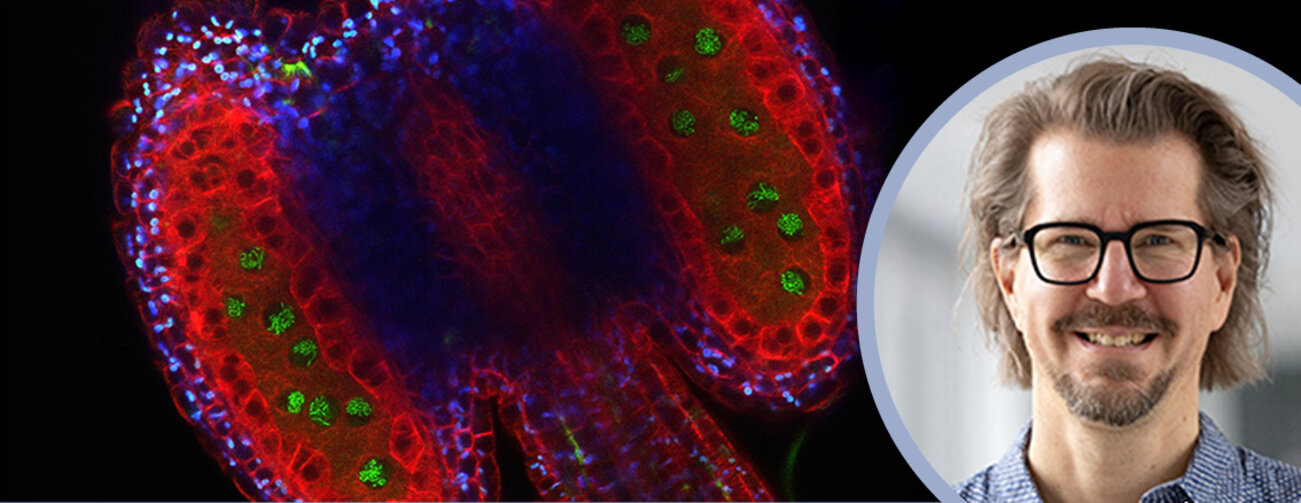
4D Life Sciences Seminar - Arp Schnittger
10-06-2025 (Maud-Menten-Saal, Campus Nord)
In his talk 'Meiosis under heat – how to sort chromosomes in times of climate change' Arp Schnittger explored the importance of ambient temperature, one of the most crucial environmental parameters for growth and fertility of most living organisms. In the course of the current climate change, extreme weather events such as heat waves have increased dramatically, and even more extreme conditions are predicted for the near future. Thus, it is of growing importance to understand how organisms and especially plants, as the major food and fodder source, respond and counter battle heat stress effects to be able to breed for heat-resilient crops. Current work has shown that the reproductive life phase of plants is very sensitive to heat and an increase in temperature often leads to sterility, not least caused by severe effects on meiotic recombination and progression through meiosis, for instance by causing the formation of unreduced gametes resulting in polyploidization. While polyploidization is thought to represent a possible mechanism of a plant to withstand stresses, it typically reduces fertility due to genomic imbalances in developing seeds and causes chromosome segregation problems in subsequent generations. In this seminar, Arp Schnittger presented the recent advances of his department in the understanding of the molecular surveillance and control mechanisms of meiosis under heat. Notably, these mechanisms include the formation of heat stress granules, a form of bimolecular condensates driven by liquid-liquid phase separation.

How to keep your leaves fresh
Ever tossed slimy spinach? Then you already know why the battle to preserve African nightshade leaves in sub-Saharan Africa matters – because no one likes perfectly good food going to waste, and this study offers a surprisingly green solution. African indigenous vegetables (AIVs) like African nightshade are crucial for nutrition and income in sub-Saharan Africa. However, their high perishability leads to significant postharvest losses. The Urban Plant Ecology Group (Christian Ulrichs) investigated biodegradable film packaging's effectiveness in preserving the quality and safety of African nightshade leaves. They compared African nightshade leaves stored in biodegradable film packs to unpacked leaves at 6°C and 20°C for seven days. The packaging reduced weight loss and better retained leaf color compared to unpacked samples. It also helped maintain health-promoting compounds. Microbial counts were reduced at 6°C but not at 20°C. Therefore, biodegradable packaging shows promise for extending the shelf life and preserving the quality of African nightshade leaves, potentially reducing food waste and improving nutritional outcomes. If you want to know more about their win-win-win-win discovery, read the full article here.

To spray or not to spray...
When pesticides are applied to protect crops, they often take out nature’s pest control agents too. Ever wondered what’s lost—and what you might be ingesting—when fields are sprayed to keep food “safe”? Beyond residues on your plate, pesticide use disrupts delicate predator-prey relationships that naturally regulate pests like aphids. The Urban Plant Ecophysiology Group (Christian Ulrichs) examined how reducing synthetic pesticide use, alongside optimizing nitrogen fertilization, influences aphid populations and their natural antagonists in wheat fields. By comparing organic, conventional, and a novel hybrid cropping system in Brandenburg, Germany, they explored how different management intensities shape insect dynamics and ecosystem health. The results suggest that farming with fewer chemicals not only supports biodiversity—it may leave a lighter ecological footprint on your fork as well. Find out more in their Landbauforschung – Journal of Sustainable and Organic Agriculture Article!

Wheat Dreams Are Made of These...
Feeding a growing global population amidst climate uncertainty demands crops that not only yield well, but yield reliably. For winter wheat—a major staple crop—achieving stable high yields is a complex challenge shaped by the interplay of plant genetics, environmental conditions, and farming practices. Identifying which plant traits contribute most to yield stability is crucial, yet difficult, due to these interacting factors. The Intensive Food Plant Systems Group(Tsu-Wei Chen) explored how different genotypic strategies and agronomic management practices influence yield stability in elite winter wheat cultivars. Over three years of field trials, they evaluated eight high-performing cultivars under varying nitrogen levels, fertilizer timing, and sowing dates. Through detailed phenotyping and multivariate analysis of over 40,000 trait values, we uncovered key physiological strategies linked to stable yields—offering valuable insights for breeding resilient, high-yielding wheat. Find out more in their Journal of Experimental Botany Article!

Continuous-Time SEMs Are Like a Box of Predictors!
Understanding how individuals change over time—and how these changes differ across groups—is a central challenge in the behavioral and social sciences. Structural equation model (SEM) trees and forests offer powerful tools for uncovering heterogeneity in SEM parameters, particularly in longitudinal data. While these methods have traditionally relied on discrete-time models, such models can produce biased estimates when measurement intervals vary, a common occurrence in real-world longitudinal studies. Recent advances have enabled SEM trees based on continuous-time (CT) models, which are more flexible with irregular measurement occasions. However, early implementations were limited by computational demands and biased results, especially for forest estimation. The Psychological Research Methods Group (Manuel Völkle)has developed a novel implementation of CT-SEM forests that overcomes these limitation and demonstrated its application using empirical data from the Survey of Health, Ageing, and Retirement in Europe. Learn more about this brand new method and how CT-SEM forests can be used in practice and reflect on their advantages and limitations in their Psychological Methods Article!

Midlife blues
Midlife is often portrayed as a period of stability, yet it can also bring a bunch of psychological and social challenges that elevate the risk of depression. Understanding the factors that shape depressive symptoms during this life stage requires a broad, integrative approach. The Developmental and Educational Psychology Group (Denis Gerstorf) examined depressive symptoms in midlife in various global contexts from a life course perspective. Using harmonized longitudinal data from over 119,000 middle-aged adults across 17 countries — including the United States, China, South Korea, Mexico, and multiple European regions — they explored how historical, sociocultural, and individual factors contribute to variations in midlife mental health. They determined significant cross-national differences, highlighting the role of individual characteristics such as education, marital status, and health, and underscoring that midlife is far from a universal experience. Find out more about your future, present or past ^^ in their Psychology and Aging Article!

AAV's Little Big Problem...
Gene therapy holds the promise to transform the treatment of genetic diseases by delivering therapeutic genes directly into patients' cells. Among the available delivery platforms, adeno-associated virus (AAV) vectors have emerged as a leading choice due to their favorable safety profile and ability to mediate long-term gene expression. However, efficient production of high-quality AAV vectors remains a challenge, as vector preparations often contain a mixture of full, empty, and partially filled capsids. Genome size is a critical factor influencing AAV packaging efficiency, vector integrity, and bioactivity. To systematically assess the effects of genome length on AAV performance, the Theory of Complex Systems and Neurophysics Group (Benjamin Lindner) designed a series of single-stranded AAV vectors with increasing expression cassette sizes by inserting non-coding stuffer sequences. If you want to learn more about how these size variations affect AAV yield, genome packaging, and functional output and receive insight into the design considerations needed to optimize vector quality for clinical applications, check out their Molecular Therapy Methods & Clinical Development Article!

Ctrl + Solve
Together with Günter Bärwolff, Caren Tischendorf just published their thoroughly revised 5th edition of their 'Numerics in physics, engineering and computer science' textbook. If ever there was a good time to learn German, it's probably now, as this book offers a clear, hands-on introduction to numerical methods for students in engineering, natural sciences, and computer science, as well as practitioners in applied fields.
Covering a wide range of topics—from linear systems and eigenvalue problems to numerical integration, ODEs, PDEs, and now machine learning and the numerical solution of Maxwell’s equations — this book bridges theory and practice with clarity and precision. Perfect for coursework and self-guided learning, this edition equips readers to tackle real-world problems with confidence. And the digital version is even free for students and staff at most universities! Anyone who still has excuses has only themselves to blame!

Solitary confinement: Pandemic edition!
The COVID-19 pandemic didn't just isolate us physically — it reshaped how we experience loneliness. While much has been said about adults feeling lonelier during lockdowns, most research has fallen short in capturing the full picture. The Developmental and Educational Psychology Group (Denis Gerstorf) investigated face-to-face data from over 7,000 German adults to map how loneliness evolved before and during the pandemic. The findings reveal three distinct patterns — from those untouched by loneliness to those hit hard during the crisis — and identify key risk factors like reduced social contact, depression symptoms, and lack of support. Interestingly, older adults were not uniquely vulnerable. The results point toward the importance of building social resilience, especially for women and those facing acute stress, to better navigate future social disruptions. Find out more in their Scientific Reports Article!

Lawn and Order!
At what point did we collectively decide that nature's wildness was something to be tamed with a lawnmower and a leaf blower? We've all seen them: the perfectly manicured lawns and meticulously swept paths that dominate our urban greenspaces. While urban rewilding — the practice of allowing city greenspaces to grow more naturally — is increasingly recognized for its benefits to biodiversity, mental well-being, and climate resilience, most urban landscapes still adhere to a elaborately groomed aesthetic. Despite the clear advantages (think thriving butterfly populations and cooler summer temperatures!), a widespread embrace of wilder urban nature remains elusive. The Landscape Ecology Group (Dagmar Haase) delved into the complex reasons behind this resistance, explored the intertwined factors of public expectations, safety concerns, and our ingrained cultural preference for tidiness. Drawing on insights from German city park managers and conservation experts, their research uncovers the barriers preventing cities from "going wild" and identifies the crucial shifts needed to unleash nature's full potential within urban environments. The path to rewilding isn't simply about planting wildflowers; it demands a fundamental rethinking of our perceptions, a significant reduction in mowing, and a redefinition of what constitutes a "beautiful" greenspace. Learn more in their Cities and the Environment (CATE) Article!

Concrete Solutions!
What if the key to surviving climate change, pandemics, and political unrest lies right outside your front door? Cities — dense, diverse, and dynamic — aren’t just where most of us live; they’re also the frontlines of today’s most urgent global challenges. As climate extremes intensify and democratic trust erodes, urban areas are uniquely positioned to lead transformative change. In this thought-provoking piece, Dagmar Haase argues that cities must become living laboratories for sustainability, resilience, and equity—places where nature, technology, and society are reimagined together. Drawing on the disruptions of the pandemic and the growing complexity of urban life, she calls for a bold, collaborative rethinking of environmental science, rooted in real people, real data, and real cities. Check out her Frontiers in Environmental Science Opinion piece!

Game of Tiers...
Why are some people better at reading emotions than others—and could social status play a role? Understanding emotions in social interactions is a crucial skill, and recent research has begun to explore how social status influences this ability across cultures. The Social and Organizational Psychology Group (Ursula Hess) examined the link between subjective social status (SSS) and emotion recognition accuracy (ERA) using a novel tool—the Assessment of Contextualized Emotion (ACE)—which emphasizes the role of social context. Participants from the Czech Republic and 12 other cultural groups worldwide completed the ACE, alongside measures of self-construal and SSS. Findings revealed that individuals with higher SSS tended to be more accurate in recognizing emotions, a relationship influenced by cultural factors such as self-construal, long-term orientation, and relational mobility. These results suggest that higher-status individuals may rely more on agentic cognitive strategies, highlighting how socio-cultural environments shape emotional understanding. Learn more in their PloS one Article!

Meat the Genes!
The German Black Pied (DSN) cattle is a rare dual-purpose breed prized for its rich milk and high-quality meat. As its population continues to decline due to competition from specialized dairy breeds, understanding the genetic basis of its valuable traits is essential for conservation and sustainable breeding. While most research has focused on milk production, this study shifts the spotlight to growth and meat-related traits. By analyzing genomic data from 669 DSN bulls, researchers identified key genetic regions and candidate genes involved in muscle growth, fat metabolism, and immune function across different developmental stages. These insights lay the groundwork for targeted breeding strategies that can help preserve and enhance the unique dual-purpose nature of the DSN breed. Check out their animal Article!

Synchronize the random!
Synchronization, the coordinated behavior of coupled oscillators, is a fundamental phenomenon observed across various scientific disciplines, from biological systems (e.g. circadian rhythms) to physical networks. While well-established theoretical tools exist for analyzing synchronization in deterministic oscillators, the inherent randomness in stochastic oscillators presents significant challenges. The Theory of Complex Systems and Neurophysics Group (Benjamin Lindner) have introduced a novel approach to this problem by employing the Q-function, a mathematical tool derived from the stochastic Koopman operator. Their work offers new insights into defining and analyzing synchronization in coupled stochastic oscillators. The paper addresses the limitations of traditional methods, like phase reduction, when applied to systems where noise complicates the very notion of a well-defined phase. By focusing on the Q-function, the slowest decaying complex mode of the system, the authors propose a new perspective: a synchronized system of coupled stochastic oscillators can be viewed as a single, higher-dimensional stochastic oscillator. This allows for a fresh examination of phenomena like Arnold tongues, which map regions of synchronization. When you are interested about the details, read this article about coupled stochastic oscillators.
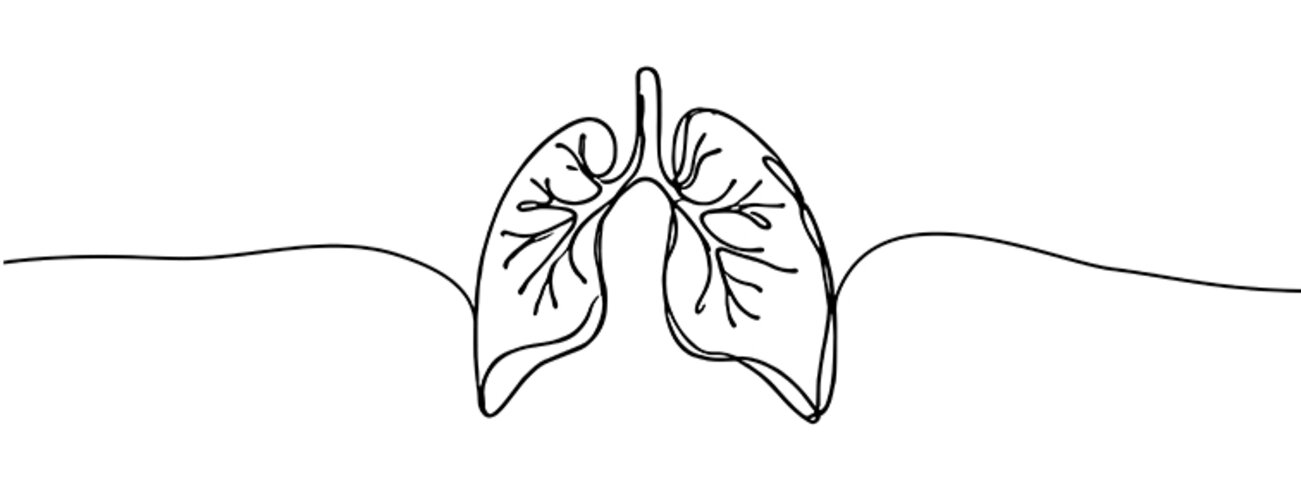
Do you be-lung with the young?
How old you feel may matter just as much as how old you are. While feeling younger has been linked to better health and well-being, most research has relied on self-reported health data. The Developmental and Educational Psychology Group (Denis Gerstorf) took a more objective approach by examining the relationship between subjective age and pulmonary function — a key biomarker tied to mortality risk. Using data from nearly 10,000 adults in the German Aging Survey over a 9-year period, they found that people who felt younger tended to have better lung function, and vice versa. These findings suggest a dynamic link between how old we feel and our physical health, with implications for healthy aging and daily well-being. Definitely have a look at their International Journal of Behavioral Development Article!

Heart and Sole!
Recovering from a stroke is a long journey, and staying physically active is vital for long-term health. Yet, many stroke survivors find it incredibly challenging to keep moving. The Developmental and Educational Psychology Group (Denis Gerstorf) examined a powerful, often overlooked, motivator: the romantic partner. They explored how both a survivor's personal drive and the support from their spouse influence daily physical activity. For two weeks, 88 stroke survivors tracked their individual and joint intentions to be active, along with their confidence levels. Their findings show that while individual motivation is important, shared goals and confidence with a partner can significantly boost self-reported physical activity. This offers crucial new insights into how couples can work together to support stroke recovery and improve overall well-being. Check out their Psychology & Health Article!

Face it! Your body's telling tales
Our faces and bodies are powerful storytellers, constantly broadcasting our inner world to those around us. A furrowed brow speaks volumes of concern, just as a beaming smile radiates joy. These nonverbal cues are fundamental for connection, allowing us to understand each other's feelings beyond spoken words. While some fundamental facial expressions of emotion like happiness, sadness, anger or fear are recognized across cultures, the intensity, frequency, and context of their display vary significantly. Cultural display rules dictate when, how, and to whom certain emotions can be shown. Furthermore, the interpretation of certain nonverbal cues, such as eye contact, physical touch, and even smiling, differs widely. The Organizational and Social Psychology Group (Ursula Hess) discussed how emotions are expressed through the face and the body, focusing on cross-cultural similarities and differences in emotion expression and the research methods used to study them. They identified three main research approaches: the reporter approach , the enactor approach and the judge approach . For each approach, the authors evaluate the methodology, discuss findings, and offer best practice recommendations. If you want to know more about emotional expressions on face and body, read their book chapter.
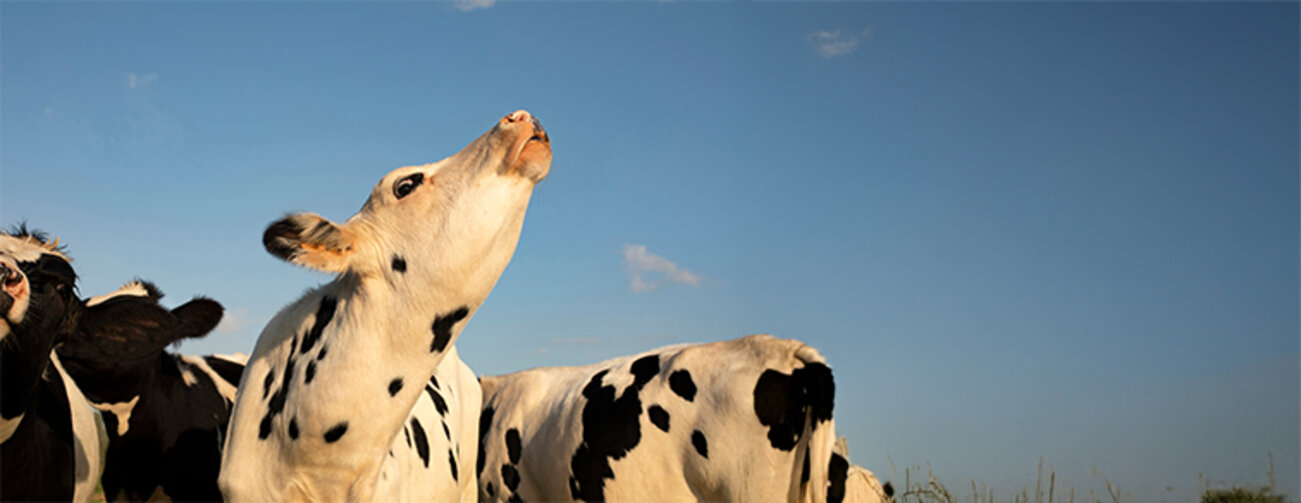
Moo-tations that matter!
Imagine a living piece of agricultural history: the German Black Pied (DSN) cattle. This endangered breed, a progenitor of the modern Holstein, offers both excellent milk and high-quality meat. To protect this valuable heritage and ensure its long-term health and productivity, the Breeding Biology and Molecular Genetics Group (Gudrun Brockmann) investigated its genetic foundations. Through a comprehensive genome-wide association study of 1,852 DSN cows, they uncovered specific genes linked to critical conformation traits, including those vital for healthy udders and robust leg structure. These discoveries are crucial for developing targeted breeding programs that will strengthen the DSN breed. Ultimately, this work benefits everyone by fostering sustainable agricultural practices, improving animal welfare, and preserving the vital genetic diversity that underpins our food systems. Find out more in their Genes Article!

No social distancing from exercise!
Physical activity offers well-documented benefits for older adults; however, this population often does not engage in sufficient levels of activity, a situation that was exacerbated by the COVID-19 pandemic. The Developmental and Educational Psychology Group (Denis Gerstorf) investigated the role of social partners in their everyday activity levels. 139 Canadian older adults participated in a daily diary study, reporting their activity and with whom they were active. The results showed less activity alone and more with their chosen close partner compared to other social contacts. These findings underscore the importance of social partners in facilitating physical activity for older adults, especially during stressful times. Find out more about this phenomenon in their Couple and Family Psychology: Research and Practice Article!

Remember this!
Quantum memories are essential tools for the future of quantum technology. They're needed for things like sending quantum information over long distances (quantum communication) and for building quantum computers. Traditional methods using hollow-core fibers have limitations, making it hard to create compact, efficient, and integrated quantum memories. The Nanooptics Lab (Oliver Benson) explored a new way to create these memories in cooperation with other researchers. They used tiny, 3D-printed structures called “light cages” to store light in a special kind of atomic gas (cesium). The big advantage is that many of these light cage memories can be built onto a single chip. This is important for creating more complex quantum systems. They carefully studied how well the light cages stored the light and how long they could hold onto it. If you want to know more about it, read the Quantum Memory article.

Dense-cities vs. open space provision
Sustainable urbanization has been a significant topic of scientific discussion in recent decades. A key point of contention is the "compact city" model and its effectiveness in addressing urban sprawl. The concept of a compact city is intricate and contentious, and there is ongoing debate about the best strategies for achieving urban sustainability, especially in different contexts such as developed versus developing countries. The Landscape Ecology Group (Dagmar Haase) investigated the balance of density and open space provision in three big cities together with two other research groups from Leipzig and São Paulo. In more detail, the research explores the relationship between urban density indicators and urban morphology, and how these factors impact the balance of built and open space in high-density residential areas across São Paulo, Brasília and Berlin. It also aims to identify the main morphological and urban density attributes related to the age of urban developments in these residential areas and their temporal context. They found out that high-rise development does not automatically ensure open space and high density. Also, some of the morphologies found in Berlin balanced housing density and Open-Space Ratio (OSR) effectively. That led to the idea that city models with perimetral blocks might be an optimal use of urban space. If you are interested in compact city modeling and research, read the whole article here.

Is my goal a carrot or a stick?
Our daily lives are often structured around pursuing various goals, from simple tasks to more significant aspirations. For older adults, this engagement in everyday goals plays a crucial role in maintaining well-being and a sense of purpose. We often experience a range of emotions as we navigate our days, and it's natural to wonder how these feelings might impact our motivation and effort in pursuing what matters to us. Furthermore, the way we think about our goals – whether we envision them as something we hope to achieve or something we fear not achieving – could also shape our actions. The Developmental and Educational Psychology Group (Denis Gerstorf) investigated the factors that influence how older individuals approach and engage with these daily goals. They further examined the intricate relationship between our everyday emotions, how we mentally frame our goals, and the extent to which we actively pursue them in our later years. Understanding these dynamics can provide valuable insights into the motivational landscape of older adulthood. Find out more in their Communications Psychology Article!

Biodiversity is key!
The urban population is rapidly increasing, with projections estimating that 68% of the global population will reside in urban areas by 2050, compared to 55% in 2018. This surge in urban population and the consequent expansion of urban land contribute to the global extinction crisis, posing a threat to biodiversity and the benefits it offers to people. The Landscape Ecology Group (Dagmar Haase) together with other researchers from Berlin, Hannover, Stuttgart, Zürich and Utrecht wrote a review that discusses the importance of urban biodiversity in an increasingly urbanized world and the challenges it faces as cities expand and densify. Urban biodiversity is people's primary contact with nature and is crucial for mitigating environmental pressures, addressing climate change, and benefiting human health and well-being. However, it is threatened by competition for space, human pressures, and declining engagement of urban residents with nature. The article emphasizes the need for high-quality urban blue-green infrastructure, biodiversity-sensitive urban governance and planning, and cross-sectional urban policies to promote sustainable, biodiverse cities for both humans and nature. If you are interested in urban biodiversity, read the Nature Reviews Biodiversity Article!

Rooting for resilience and sustainability!
Urban environments face increasing challenges from hazards like flooding, heat islands, and air pollution, necessitating innovative solutions to enhance resilience and sustainability. Green infrastructure (GI) offers a multifaceted approach to addressing these issues, yet traditional planning often overlooks the importance of tailoring GI interventions to specific local demands. The Landscape Ecology Group (Dagmar Haase) examined an adaptive framework for GI planning in Zhengzhou, a highly urbanized city, focusing on spatially identifying urban hazards through machine learning and remote sensing. After quantifying the effectiveness of various tree species in mitigating these hazards using the i-Tree Eco model, they employed an adaptive ranking approach to match tree species effectiveness with local hazard demands, revealing significant spatial heterogeneity and the need for targeted interventions. If you want to learn more about this framework which provides a valuable tool for guiding scientific decision-making in urban greening projects and ensures GI effectively addresses the unique challenges of diverse urban landscapes, check out their Urban Forestry & Urban Greening Article!

Wave goodbye to predators!
Collective behaviors in animals are often governed by simple interaction rules and raise a fundamental question: does this mechanistic simplicity translate to functional generality? Specifically, if collective behavior provides anti-predator benefits, does it offer consistent protection against diverse predators? The Collective Information Processing Group (Pawel Romanczuk) & the Mechanisms and Functions of Group-Living Group (Jens Kause) examined this question in sulphur-adapted fish populations in Mexico, where schools face predation from various bird species and respond with synchronized 'escape waves.' By observing natural interactions, they found that all bird species delayed attacks in response to increasing wave frequency, both before and after initiating predation. While post-attack wave responses were similar across bird species, pre-attack wave patterns varied, likely due to differences in perceived threat. Simulated bird arrivals confirmed this, revealing that predator size and visibility influence fish perception. This suggests that the fish's generalized collective response and its consistent impact on diverse predators stem from the waves exploiting a common weakness in visual processing, shared across different predators. Find out more in their Royal Society Open Science Article!

Cell-ebrating gene diversity!
The precise regulation of the yeast Saccharomyces cerevisiae cell cycle relies heavily on the orchestrated expression of cyclins, which activate CDK1 (cyclin-dependent kinase 1). While many cell cycle-related genes exist as paralogous pairs, they are often assumed to have redundant functions and similar expression patterns. The Theoretical Biophysics Group (Edda Klipp) challenged that notion by employing single-molecule inexpensive fluorescence in situ hybridization (smiFISH) to meticulously analyze the expression of five key paralogous gene pairs across numerous unsynchronized yeast cells. Utilizing a convolutional neural network (CNN) for precise cell cycle phase classification, they revealed significant differences in expression levels, correlation, and temporal profiles among these paralogues. Furthermore, they explored the compensatory mechanisms between paralogues upon gene deletion a functional divergence of cell cycle-related paralogues, suggesting they play distinct roles in the intricate regulation of yeast cell cycle progression. Check out their Cells Article!

Bean there, eaten that...
The concept of 'entomoponics,' which integrates plant and insect farming, offers a promising approach to sustainable resource management. The Urban Plant Ecophysiology Group (Christian Ulrichs) investigated the feasibility of utilizing vegetative waste from strawberry and common bean plants as a substrate supplement for rearing yellow mealworms (MW), a valuable source of protein. They incorporated these plant wastes, both treated and untreated, into a wheat bran-based feed and assessed the impact on mealworm yield and nutritional composition. They found that certain plant waste incorporations, particularly autoclaved bean waste and strawberry waste regardless of treatment, can maintain or even compensate for yield while influencing the mineral content of the mealworms. If you want to lean more about their valuable insights into the potential of entomoponics to convert plant waste into a nutrient-rich insect biomass which contributes to a more circular and sustainable food production system, check out their Scientific Reports Article!

My brain worm made me do it!
The lancet fluke, Dicrocoelium dendriticum, exhibits a fascinating case of parasitism with a complex life cycle involving multiple hosts. This parasite utilizes herbivores as its definitive hosts, while snails and ants serve as intermediate hosts. In their Biologie in unserer Zeit-BiuZ Review Kai Matuschewski and Richard Lucuis describe the remarkable transition from ant to herbivore, which is achieved through a division of labor within a clone of genetically identical larvae. One larva invades the ant's brain, compelling its host to expose itself on plants during cool night hours, facilitating transmission. This "brain worm's" self-sacrifice for its clone siblings raises questions about the underlying communication mechanisms and the evolutionary advantages of this strategy. Furthermore, the lancet fluke's dependence on specific dry grassland biotopes underscores the importance of nature conservation for preserving both biodiversity and the intricate life cycles of parasites. It's only available in German, but definitely worth reading for anyone who speaks the language!

The tomato whisperers...
Tomatoes are a significant source of health-promoting secondary metabolites, including carotenoids and phenolic compounds, which contribute to human well-being. Optimizing the production of these valuable compounds in greenhouse-grown tomatoes is of paramount importance. Traditionally, research has focused on the isolated effects of single environmental factors on metabolite accumulation. However, the Biosystems Engineering Group (Uwe Schmidt) developed a novel approach, leveraging multivariate time series classification of greenhouse sensor data, encompassing climatic conditions, photosynthesis, and transpiration rates, to predict secondary metabolite content. This method is able to accurately predict optimal environmental conditions for maximizing the accumulation of specific metabolites and provides the first comprehensive evidence that a holistic, time-series-based approach, considering the interplay of multiple environmental factors over a growth period, is essential for accurately predicting and optimizing secondary metabolite content in tomatoes, thus offering a powerful tool for growers to enhance the nutritional value of their crops. Find our more in their Frontiers in Plant Science Article!

Forget your keys, remember your words!
The link between intelligence and longevity has been a subject of ongoing scientific inquiry. While general intelligence is known to predict survival, the specific contributions of different cognitive abilities in old age remain poorly understood. The Developmental and Educational Psychology Group (Denis Gerstorf) addressed this gap by analyzing longitudinal data from the Berlin Aging Study, focusing on a range of cognitive tasks including perceptual speed, episodic memory, verbal fluency, and verbal knowledge. Using a sophisticated joint multivariate longitudinal survival model, they investigated the unique predictive power of each cognitive ability on mortality risk, while controlling for various demographic and health-related factors. They revealed that, among the diverse cognitive measures, only verbal fluency demonstrated a significant and unique association with survival, suggesting a more salient role for this specific ability in predicting mortality in older adults. Find out more in their Psychological Science Article!

Lettuce talk about sustainable horticulture!
The escalating issue of horticultural waste disposal presents a significant environmental and resource management challenge. In particular, tomato plant residues, a byproduct of greenhouse tomato production, represent a substantial source of untapped nutrients and organic matter. Traditional disposal methods contribute to waste accumulation and environmental burden, highlighting the need for sustainable alternatives. The Biosystems Engineering Group (Uwe Schmidt) and the Urban Plant Ecophysiology Group (Christian Ulrichs) investigated the potential of composting tomato plant residues as a viable fertilizer and soil amendment for lettuce cultivation. Harnessing the natural decomposition process to transform waste into a nutrient-rich substrate could allow closing nutrient cycles and reducing reliance on conventional fertilizers. Check out their Scientia Horticulturae Article!

Heartstrings attached!
Human interaction is a complex dance of signals, both verbal and non-verbal, that shape our attitudes and behaviors.At the heart of this dance lies emotion, a powerful force that can subtly or overtly sway our decisions and responses. In their Research Handbook on Social Influence Chapter Ursula Hess and Shlomo Hareli explore the intricate role of emotions in social influence, moving beyond simplistic notions of persuasion to delve into the nuanced ways in which feelings impact attitude change and compliance, providing a comprehensive understanding of the profound and often overlooked ways in which emotions shape and guide the social landscape. Definitely worth reading!

Predators vs. Paychecks
Human-wildlife conflicts represent a complex and persistent challenge for conservation efforts worldwide. In response, conservation performance payments have emerged as a prominent tool for mitigating these conflicts, aiming to incentivize coexistence by compensating for wildlife-related losses. In Sweden, this approach is exemplified by a payment scheme designed to address the impact of lynx and wolverine predation on reindeer husbandry, a vital practice for Sámi communities. However, the effectiveness of such schemes is often contested, and understanding the challenges and conflicts they generate is crucial for their successful implementation. The Landscape Ecology Group (Dagmar Haase) examined the intricacies of Sweden's performance payment program, employing semi-structured interviews and a systematic literature review to uncover the underlying issues. They determined a 'wicked conflict' setting, characterized by a complex interplay of direct and indirect conflicts, ranging from disputes over predator population estimates and payment adequacy to broader concerns about cumulative environmental impacts and socio-cultural recognition. If you want to gain insights into improving the efficacy of conservation performance payments and fostering more harmonious human-wildlife relationships, check out their People and Nature Article!

Guest Talk - Mario Agio
17-02-2025 (Room 2‘049, CSMB (IRIS) Building, Zum Großen Windkanal 2, Adlershof)
In his talk 'Diamond Nanophotonics and Electronics' Mario Agio took us into the world of diamonds, which have emerged as a promising platform for quantum science and technology in virtue of the unique properties of its color centers. The efficient interrogation of such centers optically and electrically remains a fundamental aspect towards quantum applications. He discussed this group's recent work on the silicon and nitrogen vacancy color centers, where both nano-optics and electronics are taken into play. Specifically, he focused on ultrafast single-photon emission, electroluminescence, nanoscale temperature sensing and vector magnetometry.

IZ LIST Day 2025
14-02-2025 (Humboldt-Kabinettl, Campus Adlershof)
The time has finally come! Today was our IZ LIST Day! We had a few presentations about exciting projects that we want to tackle in the future, provided we receive the funding. Additionally, we took plenty of time for exchange, idea creation and future planning…
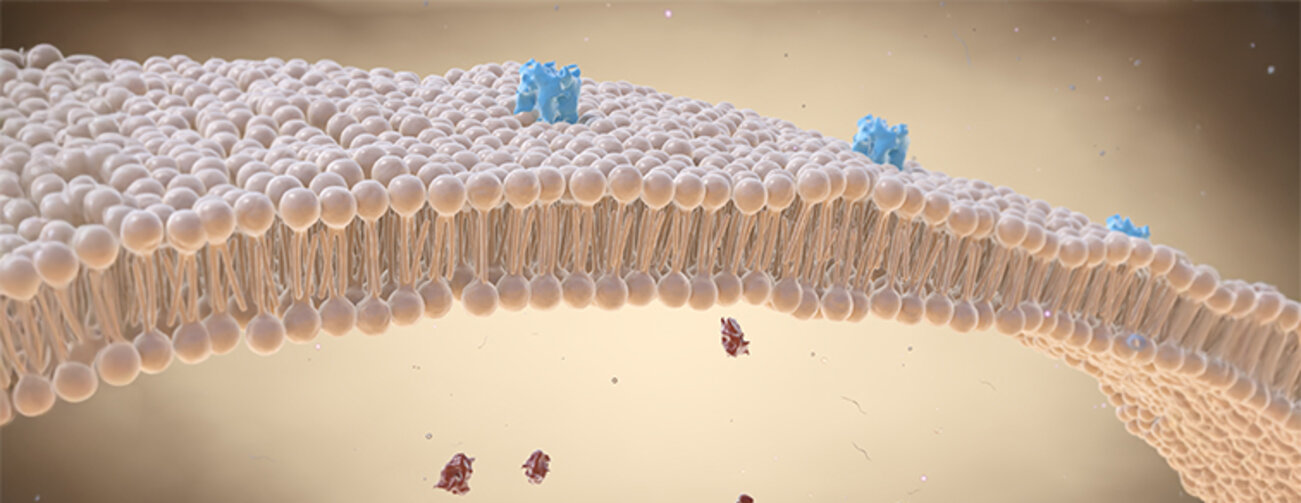
Boron to be wild…
The ability to efficiently deliver cargo into living cells is a cornerstone of advancements across chemistry, biology, and medicine. From gene therapy to drug delivery, the potential applications are vast. Cell-penetrating peptides (CPPs) have emerged as promising tools for this purpose, offering a relatively non-invasive method for transporting molecules across cellular membranes. However, optimizing CPPs for specific applications often requires enhancing their delivery efficiency and targeting capabilities. One strategy involves the conjugation of additional functional units, such as boronic acid modules, which can interact with cell surface glycans to facilitate internalization. The Bioorganic Synthesis Group (Oliver Seitz) investigated the potential of boronic acid conjugation to transform non-CPP peptides into functional delivery vehicles. If you want to know more about boronic acid-mediated CPPs and their potential for targeted cellular delivery, check out their Chembiochem: a European journal of chemical biology Article!

Arresting Malaria!
Malaria remains a significant global health challenge, necessitating the development of effective vaccines. A promising approach involves the use of genetically attenuated (GA) Plasmodium falciparum parasites. These modified parasites are designed to be metabolically active but unable to progress fully through the parasite's life cycle, thus stimulating an immune response without causing disease. Together with Julius Hafalla and Steffen Borrmann, Kai Matuschewski has summarized recent advances made by Lamers et al. and Roozen et al. which you can read in their Trends in Parasitology Spotlight Article!

Moo-ving forward!
Genetic improvement in livestock offers significant potential for enhancing traits like milk production, meat quality, disease resistance and generally better health, contributing to more sustainable and profitable farming practices. The Breeding Biology and Molecular Genetics Group (Gudrun Brockmann) investigated single-step genomic prediction in the German Black Pied cattle breed, focusing on key traits like protein percentage, fat-to-protein ratio, and stature. They compared the performance of a breed-specific SNP chip with a commercially available one, and explored the impact of these predictions on ongoing optimum genetic contribution selection, aiming to maximize genetic gain while maintaining genetic diversity. They also examined the influence of inbreeding and optimized selection strategies to improve overall breeding index. If you want to learn more about their finding, check out their Journal of Animal Breeding and Genetics Article!

Your trash is my treasure...
Hemp waste is a byproduct of hemp cultivation, but presents a potential resource for insect-based bioconversion, offering a sustainable approach to waste management and protein production. However, the nutritional profile of hemp waste may not be optimal for insect growth, and the presence of bioactive compounds like cannabinoids can pose challenges. Solid-state fermentation (SSF), utilizing fungi, offers a promising strategy to enhance the nutritional value of such substrates. The Urban Plant Ecophysiology Group (Christian Ulrichs) investigated the impact of SSF with various fungal species on hemp waste, examining its effects on black soldier fly larvae (BSFL) growth and the fate of hemp cannabinoids, flavonoids, and terpenes. If you want to know more about how different fungal species can tailor the properties of hemp waste, improving its suitability as a BSFL feed and potentially modulating the levels of valuable or undesirable compounds, check out their Frontiers in Bioengineering and Biotechnology Article!
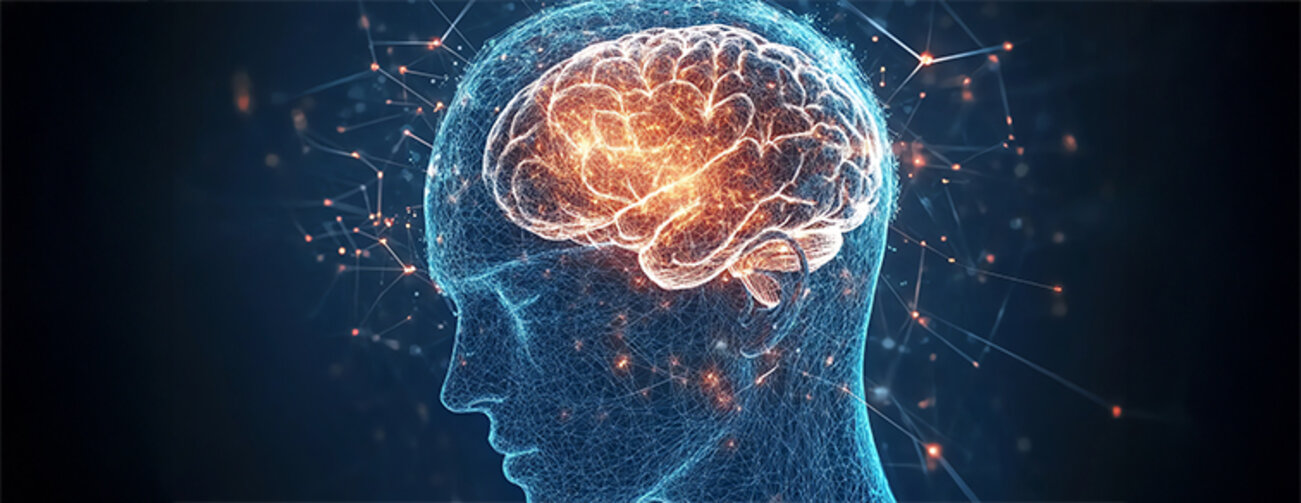
Two senses are better than one!
Our working memory, which is our ability to hold information in mind for short periods, is known to be limited. While previous research has demonstrated that recalling similar items becomes less precise as the number of items increases, it remains unclear how the diversity of information, particularly across different senses and features, affects recall. The Distributed Cognition and Memory Group (Thomas Christophel) investigated how varying the types of items held in working memory—specifically focusing on modality (e.g., visual vs. auditory) and feature (e.g., orientation, pitch, color)—impacts recall precision. Examining these effects in two different experiments, they observed a surprising advantage for cross-modal and certain cross-feature combinations, suggesting that working memory organization is more nuanced than previously thought and dependent on modality, feature, and even the strategies used to encode information. If you want to learn more about this fascinating results, check out their Journal of Vision Article!

From grain to gain!
Understanding how crop varieties perform across different environments and management practices is essential for improving agricultural productivity and resilience. Multi-environmental trials (METs) provide valuable data for dissecting these complex genotype-environment-management (GxExM) interactions. The Intensive Food Plant Systems Group (Tsu-Wei Chen) generated a comprehensive MET dataset for winter wheat in Germany, spanning six years, six locations, and nine different management scenarios. This rich dataset, encompassing over half a million data points and 24 traits – including yield, agronomic characteristics, baking quality, and disease indices – offers a powerful resource for addressing key agronomic questions, informing breeding strategies, and developing decision support tools for sustainable agriculture. Find out more about their discoveries in their Scientific Data Article!

Can we have our cake and eat it too?
Rapid urbanization often comes at the cost of diminished green spaces and weakened ecosystem services, creating a potential conflict between ecological health and socio-economic development. Finding a balance between these competing priorities is crucial for sustainable urban growth. The Landscape Ecology Group (Dagmar Haase) established a novel framework for quantifying this urban-ecological trade-off, using a return-on-investment perspective that links degraded ecological conditions with urban land use efficiency.Focusing on the rapidly expanding city of Zhengzhou, China, they assess four key ecological conditions – urban heat island effect, flood regulation, habitat quality, and carbon sequestration – alongside land use efficiency at a fine spatial scale. By analyzing these factors over two decades, they explored the dynamics of the urban-ecological trade-off to the key drivers influencing it and ultimately proposing adaptive management strategies to guide sustainable urban planning. Check out their Remote Sensing Article!

Face it - You only copy what you care about!
Emotional mimicry - the mirroring of another person's facial expressions - is a key component of empathy and social interaction.While it's generally understood that we mimic the emotions of those we're engaging with, it's less clear how our brains handle emotional information that's present but not directly relevant to the task at hand. The Social and Organizational Psychology Group (Ursula Hess) investigated whether we mimic emotions from faces we are instructed to ignore, even though those faces are still visually processed. If you are interested whether task-irrelevant faces are simply not processed or if their presence has a more nuanced effect on our empathic responses, check out their Frontiers in Psychology Article!

24 genes walk into a working memory study…
Working memory (WM) is a fundamental cognitive function, and while genetic studies have identified numerous associated variations, the role of gene expression in WM remains largely unexplored. The Molecular Psychology Group (Sebastian Markett) developed a novel approach to investigate the genetic basis of WM by integrating connectome, transcriptome, and genome data. Using a high-quality dataset of 481 Chinese adults, they identified WM-related brain regions, then determined differentially expressed genes within those regions using the Allen Human Brain Atlas. These findings could subsequently be validated in two independent, large-scale datasets. If you want to know more about this powerful method check out their Human Brain MappingArticle!

Mind the Gap!
Visual working memory is the cognitive system that allows us to temporarily hold and manipulate visual information in mind. Verbal storage is the component of working memory that holds and manipulates information in a phonological (sound-based) form, such as words or numbers. Typically the two elements are studied as separate cognitive functions. However, the act of naming visual stimuli may influence performance on visual working memory tasks, with some research suggesting benefits and other research indicating potential biases.The Distributed Cognition and Memory Group (Thomas Christophel) investigated the verbal labels people naturally associate with simple visual-spatial stimuli and how these labels relate to recall accuracy in a subsequent working memory task. Focusing on orientation and location stimuli, their research investigates the diversity of labels used and their impact on known biases in visual working memory, such as the cardinal direction bias, the phenomenon where people tend to remember orientations or locations closer to cardinal directions (north, south, east, west) more accurately than those in between. If you want to know more about the potential shared cognitive resources underlying both visual-spatial and verbal memory, check out their Journal of Cognition Article!

